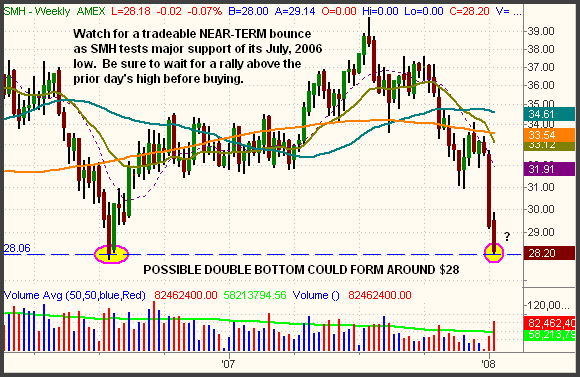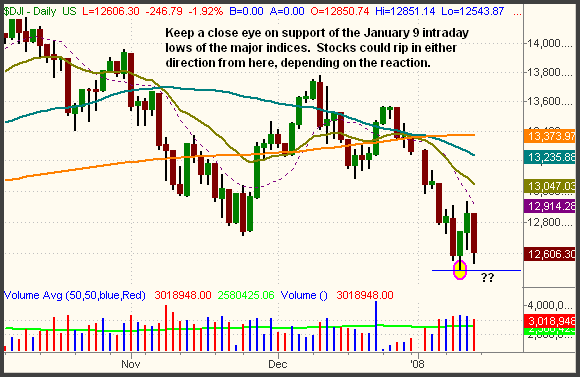| The Wagner Daily ETF Report for January 14 |
| By Deron Wagner |
Published
01/14/2008
|
Stocks
|
Unrated
|
|
|
|
The Wagner Daily ETF Report for January 14
Largely blowing off the bullish mid-week reversal, the stock market sustained another round of substantial, broad-based losses last Friday, The Nasdaq Composite swooned 2.0%, the Dow Jones Industrial Average 1.9%, and the S&P 500 1.4%. The small-cap Russell 2000 and S&P Midcap 400 indices fell 2.2% and 1.4% respectively. A modest bounce in the final forty-five minutes of trading lifted stocks off the session's lows, but each of the main stock market indexes still finished in the bottom quarter of their intraday ranges.
Total volume in the NYSE declined 14%, while Nasdaq volume came in 10% lighter than the previous day's level. Still, turnover in both exchanges remained above 50-day average levels for the sixth consecutive day. Market internals were firmly negative. Declining volume in the NYSE exceeded advancing volume by a margin of just under 3 to 1. The Nasdaq ratio was negative by 7 to 2.
Last week, we scored a nice profit from a quick trade on the long side of the S&P Financial SPDR (XLF). As it was stuck in a sustained primary downtrend, we were only interested in trading a short-term reversal of momentum that began with the broad market's reversal on Wednesday. The play worked out well, enabling us to sell one day later for a snappy 3% gain. Going into this week, another ETF that may offer a similar near-term bounce is the Semiconductor HOLDR (SMH). Looking at its weekly chart, notice how SMH closed right at major support of its prior low from July of 2006:

Odds are good that such a major level of support will lead to a tradeable bounce on the long side of SMH. However, it's very important for the price action to first confirm the reversal of momentum, rather than blindly jumping in and picking a bottom. We did the same with XLF last week, waiting for a rally above its 20-MA on the hourly chart before buying it. In the case of SMH, a similar entry is a rally above last Friday's high of $28.67. Waiting for SMH to first clear that price is the only way to have relatively low-risk when trading a countertrend bounce on a weak ETF. Obviously, a protective stop just below last Friday's low is crucial to protect against a failed reversal. As with the XLF trade, only traders and investors comfortable with very short-term timeframes should consider an entry in SMH. For now, its downtrend is simply too strong to anticipate anything more than a rapid one to three day bounce off the lows.
Last Friday's losses erased a majority of the stock market's gains scored in the two preceding days. This raises the possibility that the major indices fall to new lows within the next several days, but a near-term "double bottom" could just as easily form near the January 9 intraday lows. The close proximity to this key test of support is shown on the daily chart of the Dow Jones Industrial Average below:

If support is found near last week's low, traders and investors may be more comfortable initiating new long positions because there would at least be some indication that a near-bottom bottom may have formed. If that happens, we should expect to see a swift rally above last week's highs in the coming days. One could reasonably expect a rally up to resistance of the 50-day MAs of the S&P, Nasdaq, and Dow. Nevertheless, it would not be shocking if stocks sliced right through support of their January 9 lows. Keep in mind that overall momentum continues to favor the bears, and the market is no longer "oversold."
As either the bullish or bearish scenario above is a good possibility, the best plan of action over the next few days is to set alerts for the price levels of the January 9 intraday lows, then be prepared for possible action in either direction. The exact levels of near-term support are as follows: S&P 500 - 1,378, Nasdaq Composite - 2,407, and the Dow Industrials - 12,501. Until the market clearly shows its hand, the biggest concern is being heavily invested on the wrong side of the market at an area where momentum could rip in either direction. We continue to be primarily positioned in cash, stealthily shooting like a sniper with select near-term ETF trade setups. "Defensive" sector ETFs such as the Pharmaceutical HOLDR (PPH) are still the best bets on the long side.
Open ETF positions:
Long - (none)
Short - (none)
Deron Wagner is the Founder and Head Trader of both Morpheus Capital LP, a U.S. hedge fund, and Morpheus Trading Group, a trader education firm launched in 2001 that provides daily technical analysis of the leading ETFs and stocks. For a free trial to the full version of The Wagner Daily or to learn about Wagner's other services, visit MorpheusTrading.com or send an e-mail to deron@morpheustrading.com.
|